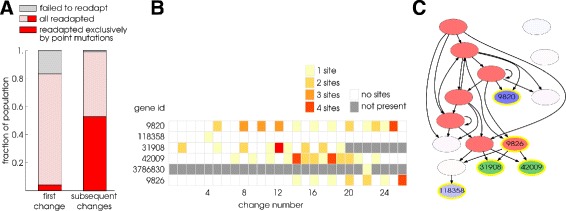Fig. 5.

Mutational priming in the GRN. a Fraction of changes where populations in environment 1 needed only point mutations to readapt. This was measured by examining mutations found in the LOD, from the generation immediately after a change occurred until an individual with fitness >0.7 was found. The first pair of changes back and forth is compared to all subsequent changes. b At the time points before each (numbered) environmental change we plot, for individuals in the LOD of a sample evolutionary run, the number of primed sites of all the genes in the genome. We systematically mutate all parameters (sites) of all genes in the genome. If mutating a site can restore fitness to >0.7 in the alternative environment then this site is a primed site of a gene. A gene can have more than one site (parameter) that is primed, as indicated by the colour of the squares. Only genes are plotted that have at least one primed site at some point during the evolutionary simulation. Genes that come into existence only later, after duplication, or disappear due to deletion, are partly greyed in the plot. c shows the GRN at the halfway point of the simulation (change 13) where genes with ‘primed sites’ are indicated by yellow outlines. Note that at a subsequent evolutionary time point enzyme 31908 is deleted from the genome and enzyme 3786830 exists only transiently in the genome between change 22 and 23. Red: TFs, green: catabolic enzymes, blue: anabolic enzymes, purple: pumps. Arrows indicate regulation (both positive and negative) by TFs. The colour saturation indicates gene essentiality, measured as the relative loss in fitness loss upon knockout (deletion) of the gene. Note that the colourless gene is in fact a TF with very low essentiality value.
